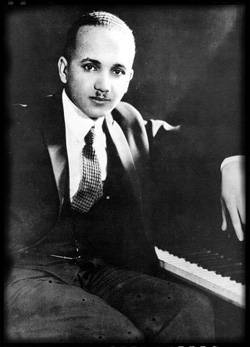|
Horace, who also played piano, led bands, and was a gifted arranger. Henderson received a good education, majoring in chemistry and mathematics at Atlanta University, but during a 1920 postgraduate sojourn in New York he worked part-time as a pianist and became known to W.C. Handy, who employed him in his band. In 1922 he took work as house pianist and recording producer at the independent Black Swan records, the following year appearing for other labels as an in-demand accompanist for a huge range of singers, including Bessie Smith and Ethel Waters. Late that year he landed a job at the Club Alabam, and in January 1924 began leading his own band there. Before long he was resident with his band at the Roseland Ballroom and had a wealth of talent employed in its ranks, including Coleman Hawkins, Buster Bailey, and, most importantly, Louis Armstrong. Henderson’s was the premier big band in jazz, and not just because of the strong solo characters: he and his staff were evolving a method of arrangement which would in time become incorporated into every jazz big band, whatever style it played. Using the then prevalent two-beat rhythm of early jazz, Henderson concentrated on using each instrumental group – trumpets, trombones, reeds, piano, rhythm – in contrast and counterpoint to each other, thereby automatically providing color, contrast, and secondary interest to each melody and harmonic progression, especially as the idea of riffs (simple repetitive melodic devices) evolved fully.
Henderson’s arrangements were models of simplicity and clarity, his methods easily adaptable to the demands of swing rhythm as the more even four-beat feel of the 1930s became the norm. Yet Henderson himself was not the principal beneficiary of his own innovations: by all accounts in 1928 he suffered a major car accident, receiving head injuries which left a permanent mark: he left most day-to-day affairs after that to his wife. By the early 1930s Henderson was writing arrangements for many bands and with the rise of Benny Goodman in 1934-35 he was a prime source for Goodman’s superior swing feel. Yet the inadequacies of Henderson’s own leadership can easily be detected when a Henderson band and a Goodman band performance of a song – for example, “King Porter Stomp” or “Honeysuckle Rose” – are compared, the fire and discipline in the Goodman band being in a different class. Henderson maintained a band with varying personnel and success and with regular breaks, up to 1939, when he briefly became Goodman’s pianist; after that his own band leading was occasional, and he was most often employed by stars such as Ethel Waters, and Goodman for playing or arranging work. A return of sorts to active leadership in 1950 was curtailed by a stroke, after which Henderson was virtually housebound until his death in December 1952.
0 Comments
Leave a Reply. |
Jazz LegendsA blog on the great legends in Jazz. Information via "The Encyclopedia of Jazz and Blues". Archives
December 2017
Categories |

 RSS Feed
RSS Feed

